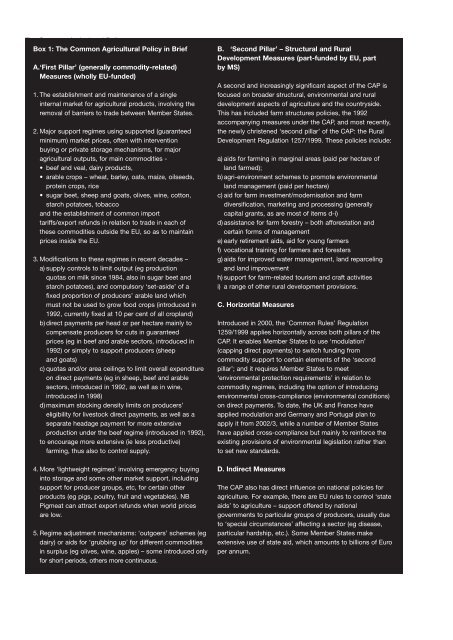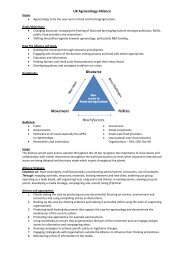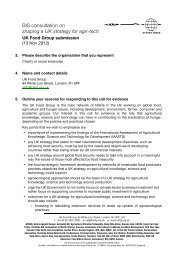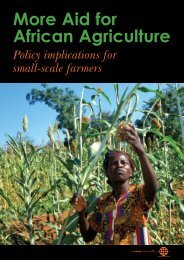Common Agricultural Policy - UK Food Group
Common Agricultural Policy - UK Food Group
Common Agricultural Policy - UK Food Group
Create successful ePaper yourself
Turn your PDF publications into a flip-book with our unique Google optimized e-Paper software.
The <strong>Common</strong> <strong>Agricultural</strong> <strong>Policy</strong><br />
Box 1: The <strong>Common</strong> <strong>Agricultural</strong> <strong>Policy</strong> in Brief<br />
A.‘First Pillar’ (generally commodity-related)<br />
Measures (wholly EU-funded)<br />
1. The establishment and maintenance of a single<br />
internal market for agricultural products, involving the<br />
removal of barriers to trade between Member States.<br />
2. Major support regimes using supported (guaranteed<br />
minimum) market prices, often with intervention<br />
buying or private storage mechanisms, for major<br />
agricultural outputs, for main commodities -<br />
• beef and veal, dairy products,<br />
• arable crops – wheat, barley, oats, maize, oilseeds,<br />
protein crops, rice<br />
• sugar beet, sheep and goats, olives, wine, cotton,<br />
starch potatoes, tobacco<br />
and the establishment of common import<br />
tariffs/export refunds in relation to trade in each of<br />
these commodities outside the EU, so as to maintain<br />
prices inside the EU.<br />
3. Modifications to these regimes in recent decades –<br />
a) supply controls to limit output (eg production<br />
quotas on milk since 1984, also in sugar beet and<br />
starch potatoes), and compulsory ‘set-aside’ of a<br />
fixed proportion of producers’ arable land which<br />
must not be used to grow food crops (introduced in<br />
1992, currently fixed at 10 per cent of all cropland)<br />
b) direct payments per head or per hectare mainly to<br />
compensate producers for cuts in guaranteed<br />
prices (eg in beef and arable sectors, introduced in<br />
1992) or simply to support producers (sheep<br />
and goats)<br />
c) quotas and/or area ceilings to limit overall expenditure<br />
on direct payments (eg in sheep, beef and arable<br />
sectors, introduced in 1992, as well as in wine,<br />
introduced in 1998)<br />
d) maximum stocking density limits on producers’<br />
eligibility for livestock direct payments, as well as a<br />
separate headage payment for more extensive<br />
production under the beef regime (introduced in 1992),<br />
to encourage more extensive (ie less productive)<br />
farming, thus also to control supply.<br />
4. More ‘lightweight regimes’ involving emergency buying<br />
into storage and some other market support, including<br />
support for producer groups, etc, for certain other<br />
products (eg pigs, poultry, fruit and vegetables). NB<br />
Pigmeat can attract export refunds when world prices<br />
are low.<br />
5. Regime adjustment mechanisms: ‘outgoers’ schemes (eg<br />
dairy) or aids for ‘grubbing up’ for different commodities<br />
in surplus (eg olives, wine, apples) – some introduced only<br />
for short periods, others more continuous.<br />
B. ‘Second Pillar’ – Structural and Rural<br />
Development Measures (part-funded by EU, part<br />
by MS)<br />
A second and increasingly significant aspect of the CAP is<br />
focused on broader structural, environmental and rural<br />
development aspects of agriculture and the countryside.<br />
This has included farm structures policies, the 1992<br />
accompanying measures under the CAP, and most recently,<br />
the newly christened ‘second pillar’ of the CAP: the Rural<br />
Development Regulation 1257/1999. These policies include:<br />
a) aids for farming in marginal areas (paid per hectare of<br />
land farmed);<br />
b) agri-environment schemes to promote environmental<br />
land management (paid per hectare)<br />
c) aid for farm investment/modernisation and farm<br />
diversification, marketing and processing (generally<br />
capital grants, as are most of items d-i)<br />
d) assistance for farm forestry – both afforestation and<br />
certain forms of management<br />
e) early retirement aids, aid for young farmers<br />
f) vocational training for farmers and foresters<br />
g) aids for improved water management, land reparceling<br />
and land improvement<br />
h) support for farm-related tourism and craft activities<br />
i) a range of other rural development provisions.<br />
C. Horizontal Measures<br />
Introduced in 2000, the ‘<strong>Common</strong> Rules’ Regulation<br />
1259/1999 applies horizontally across both pillars of the<br />
CAP. It enables Member States to use ‘modulation’<br />
(capping direct payments) to switch funding from<br />
commodity support to certain elements of the ‘second<br />
pillar’; and it requires Member States to meet<br />
‘environmental protection requirements’ in relation to<br />
commodity regimes, including the option of introducing<br />
environmental cross-compliance (environmental conditions)<br />
on direct payments. To date, the <strong>UK</strong> and France have<br />
applied modulation and Germany and Portugal plan to<br />
apply it from 2002/3, while a number of Member States<br />
have applied cross-compliance but mainly to reinforce the<br />
existing provisions of environmental legislation rather than<br />
to set new standards.<br />
D. Indirect Measures<br />
The CAP also has direct influence on national policies for<br />
agriculture. For example, there are EU rules to control ‘state<br />
aids’ to agriculture – support offered by national<br />
governments to particular groups of producers, usually due<br />
to ‘special circumstances’ affecting a sector (eg disease,<br />
particular hardship, etc.). Some Member States make<br />
extensive use of state aid, which amounts to billions of Euro<br />
per annum.





